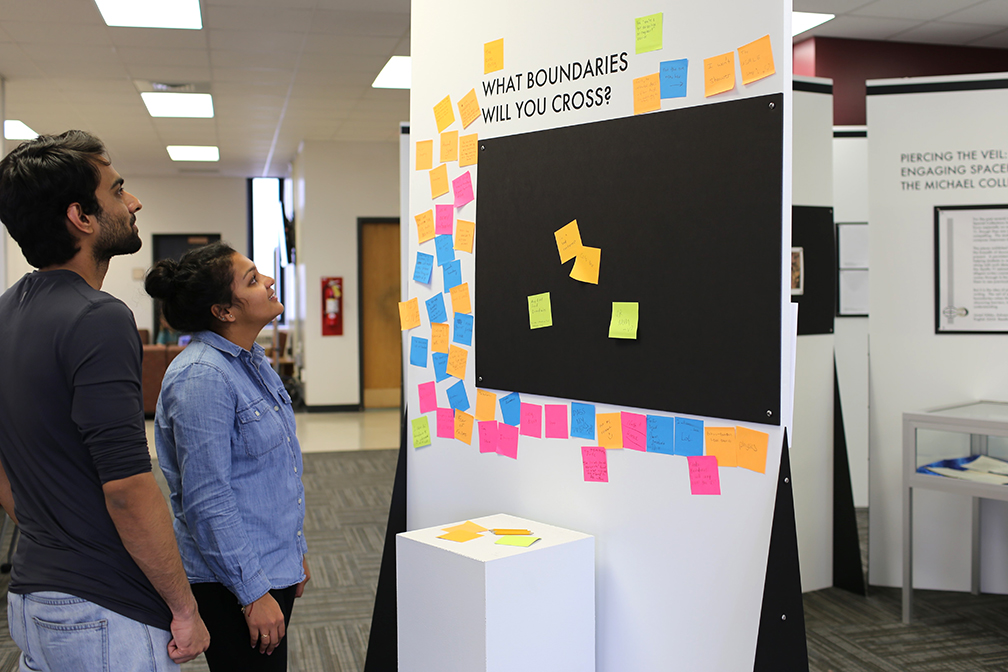Piercing the Veil
March 29, 2018

What would Neil Armstrong have tweeted in 1969 after he set foot on the surface of the moon? How would each of the astronauts from the Apollo 11 mission — Buzz Aldrin, Neil Armstrong, and Michael Collins — be described in a traditional, senior-superlative fashion in a fictitious 2017-2018 yearbook?
These are examples of some of the creative and critical works that students of Jared Gibbs, a faculty member in the Department of English, created in response to studying the Michael Collins papers in the University Libraries Special Collections.
Piercing the Veil: Engaging Spaceflight Through the Michael Collins Papers exhibit, which includes poetry, mixed media, critical reflection, and other responses by Gibbs’ students, is on display until May 30, 2018, on the second floor of Newman Library as a part of the University Libraries’ course exhibit initiative.
Special collections archivist Marc Brodsky has worked with Gibbs’ class for several semesters and introduced students to the Michael Collins papers. “The best part about this project for me is the opportunity to work with students who do not have experience researching or exploring original documents,” said Brodsky.
For example, Gibbs and Brodsky introduced the students to an original letter written by Charles Lindbergh to Michael Collins just after completion of the Apollo 11 mission. Lindbergh was the first to complete a nonstop solo transatlantic flight, and Collins was the first to complete a solo orbit around the moon. In the letter, Lindbergh speaks to the shared experience of the two flyers, each in his own realm and by himself, seeing a world as no one had before.
“What a fantastic experience it must have been — the first man alone looking down on another celestial body, like a god of space! There is a quality to aloneness that those who have not experienced it cannot know — to be alone and then to return to our fellow man once again,” Lindbergh wrote in his letter to Collins. “You have experienced an aloneness unknown to man before. I believe you will find that it lets you think and sense with greater clarity. Sometime in the future, I would like to listen to your own conclusions in this respect,” wrote Lindbergh.
“I’m here to introduce students to the power of primary source documents to inspire, surprise, or to fire one’s imagination,” Brodsky said.
“I’m constantly impressed by the responses I get from students both critically and creatively to the Michael Collins materials,” said Gibbs. “The students get to experience research in a way that we usually don’t anymore — without digital interfaces and the internet,” added Gibbs.
The class assignment was to create a response to the original documents they experienced in Special Collections, which included newspaper clippings, personal letters to Collins, and written reflections by Collins.
“These original documents enabled students to engage in history in a way that is compelling and stimulating to them. The time of Apollo 11 is an interesting time in history, but also Michael Collins was a writer, a champion of the humanities, and director of the Smithsonian’s Air and Space Museum after his career as an astronaut. So, students find multiple ways to relate to him,” said Gibbs.
This is the first time Gibbs challenged his class, Reading and Writing Across English Studies, to create their materials for a course exhibit in Newman Library. “The experience of preparing materials for display, of writing and thinking with a real audience in mind, allowed them to think about practical rhetorical concerns and matters of presentation and polish that can sometimes be difficult in a classroom setting. They were thinking beyond preparing materials for a teacher to presenting materials to a real audience — beyond the classroom,” added Gibbs.
Now that Gibbs and his students experienced collaborating with the University Libraries on the course exhibit, he looks forward to enhancing this “beyond the classroom” experience in the future. It is an opportunity to “have students methodically think about how this work will be viewed, how readers and viewers will engage with it, the strengths and weaknesses of different design choices and writing choices. This is beneficial to students in building practical knowledge,” added Gibbs.
To learn more, watch the video about Piercing the Veil and the University Libraries course exhibit initiative.
Written by Ann Brown







